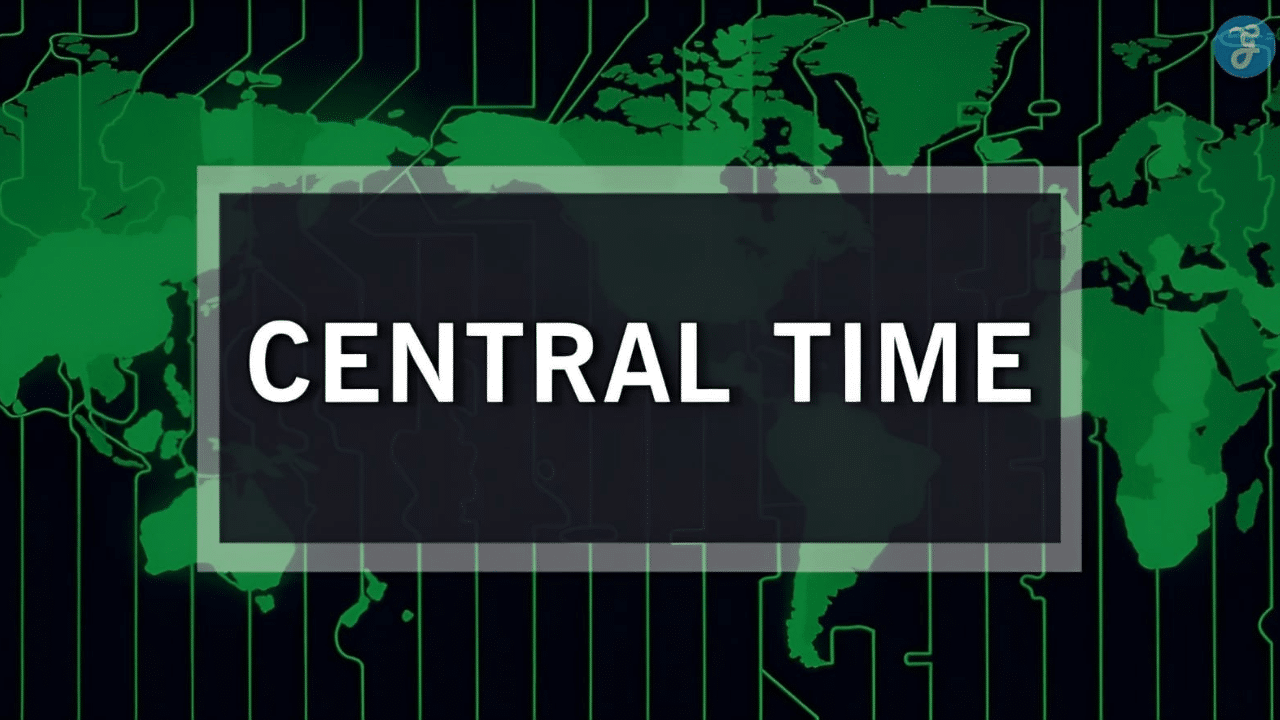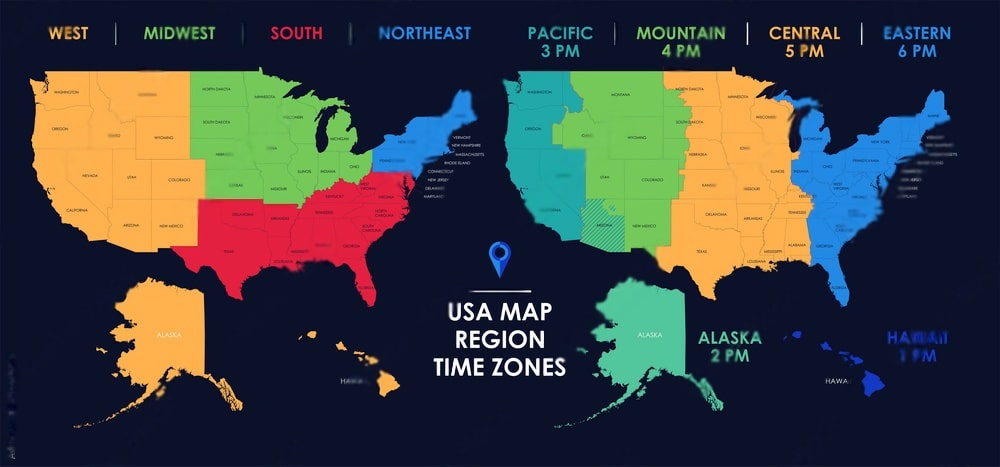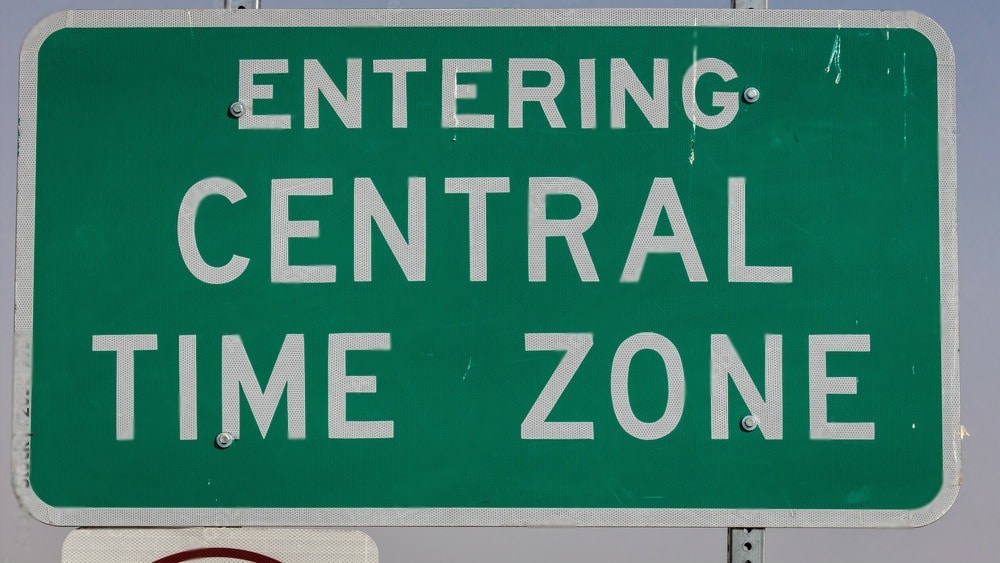Navigating the intricacies of time zones can be complex, but with Central Time influencing a significant chunk of North America, it’s important to understand its key aspects. Spanning multiple states in the US and provinces in Canada, this time zone plays a pivotal role in dictating our daily routines and schedules.
This comprehensive guide will give you everything you need to know about Central Tim,e from its introduction and impact on Daylight Saving Time to its influence on worldwide business operations.
Let’s dive into the world of Central Time!
Content Highlights
- Central Time is a time zone in North America six hours behind Coordinated Universal Time (UTC-6).
- The Central Time Zone spans multiple states in the US and provinces in Canada, including Texas, Illinois, Louisiana, and Manitoba.
- Daylight Saving Time starts on Sunday, March 12, 2024, at 2: 00 A.M. and ends on the first Sunday in November for most areas of the United States.
- Several countries worldwide observe Central Time, including Mexico, Belize, Guatemala, Honduras, Nicaragua, Costa Rica, and El Salvador.
What is Central Time?
Central Time is a time zone in North America six hours behind Coordinated Universal Time (UTC-6).
Definition and Explanation
Central Time, often abbreviated as CT, is a standard time term used to describe the local time in regions observing Central Standard Time (CST) or Central Daylight Time (CDT).
Generally speaking, Central Standard Time is observed during winter months, wherein clocks remain unchanged. By contrast, during summer, when daylight saving is in effect, these areas shift to Central Daylight Time with clocks moved forward by one hour to better utilize daylight.
This time zone falls six hours behind Coordinated Universal Time (UTC-6), making it widely relevant for scheduling events, telecommunications, and broadcasting among different regions.
The CT covers vast geographical bounds from the Gulf Coast to the Canadian border, including several US states like Texas and Illinois and parts of Canada.
Time Zone Boundaries
Geographical boundaries and political divisions primarily delineate the Central Time Zone in the United States. These boundaries signify the different regions observing Central Time.
- In the Eastern United States, the Central Time Zone sits west of the boundary dividing it from the Eastern Standard Time Zone.
- The time zones implemented under acts such as the Standard Time Act and, later, the Uniform Time Act indicate this change geographically.
- The starting point of the Central time zone is marked in Tennessee; however, it’s widespread across several states and territories extending into Canada and Mexico.
- 9-time zone boundaries exist within the United States territories, including that of Central Time.
- Due to political preferences or geographical convenience, certain states observe a partial division between Central time and neighboring Mountain or Pacific Standard times.
- For an easy reference on how these zones are divided, resources like timeanddate.com provide comprehensive real-time maps showing current local times for each region globally, including areas observing daylight saving changes.
- Beyond North America’s borders, numerous countries – from parts of Central America to island nations in the Caribbean – fall within this boundary, also observing Central Time.
Offset from Coordinated Universal Time (UTC)
The Central Time Zone is essential to the Coordinated Universal Time (UTC), a worldwide time standard for defining time zones. As a rule, Central Time typically sits at UTC-6 hours, serving as its offset from UTC.
This means your local time is generally six hours behind the global standard in this zone. The significance of such offsets cannot be understated. It enables precise conversion between local and UTC times – which is key in arranging activities across borders and preventing confusion in urgent situations.
However, consider that factors like daylight saving can temporarily modify this offset and change the comparison between regional time and UTC. Knowledge of these variations ensures accuracy in scheduling and effective international communication, making it paramount for anyone dealing with multiple regions or countries observing Central Time.
Daylight Saving Time in Central Time
Daylight Saving Time in Central Time starts and ends on specific dates, impacting the time change in the region.
When Does Daylight Saving Time Start and End in Central Time?
- Daylight Saving Time in Central Time begins on Sunday, March 12, 2024, at 2: 00 A.M.
- Clocks are set forward 1 hour (losing one hour) to “spring forward” during the start of Daylight Saving Time.
- The time change for Daylight Saving Time also occurs on the second Sunday in March.
- Daylight Saving Time in most areas of the U.S. ends on the first Sunday in November.
- During the end of Daylight Saving Time, clocks are moved forward one hour.
- The current Daylight Saving schedule in the United States was introduced in 2007.
- Daylight Saving Time was enacted as a legal requirement by the Uniform Time Act 1966.
- The Uniform Time Act of 1966 was motivated by transportation improvements.
- Some states are considering getting rid of Daylight Saving Time in 2024.
- Efforts are being made to eliminate the clock changes altogether.
- Daylight Saving Time has historical roots in transportation advancements.
- Daylight Saving Time changes occur at 2: 00 A.M. in the United States.
Impact on Time Change
Daylight Saving Time in the Central Time zone significantly impacts our daily lives. When the clocks “spring forward” one hour, it may disrupt our sleep patterns and leave us groggy and irritable.
Research suggests that this time change can affect our bodies in various ways. However, there are ongoing efforts to address this issue. The US Senate passed a bill to make Daylight Saving Time permanent starting in 2024, which could eliminate the hassle of adjusting our clocks twice a year.
While opinions on Daylight Saving Time vary, it’s worth noting that some studies have shown a decrease in crime rates during these extended daylight hours. Ultimately, whether or not you’re a fan of changing your clocks, it’s important to be aware of the potential impact on your schedule and well-being.
Central Time Observing States
The article will provide a list of states in the United States that observe Central Time and an overview of regions and cities within this time zone.
Overview of Regions and Cities in Central Time
The Central Time Zone spans various regions and cities in North America. States such as Texas, Illinois, Louisiana, and Minnesota observe Central Time in the United States.
Major cities within this time zone include Chicago, Houston, New Orleans, Dallas, and Minneapolis. In Canada, provinces such as Ontario and Manitoba observe Central Time. Other countries that adopt Central Time include Mexico and several nations in Central America.
With a rich history dating back to establishing time zones in the United States before World War I, Central Time significantly coordinates daily activities for millions across these regions and cities.
Central Time Observing Provinces in Canada
The provinces of Manitoba and Saskatchewan observe Central Time in Canada. These provinces follow the time zone boundaries within Canadian Central Time, providing consistency in scheduling and coordination with neighboring regions.
Provinces in Canada that observe Central Time
3 provinces in Canada observe Central Time:
- Manitoba: The entire province of Manitoba observes Central Time.
- Saskatchewan: Most of the province of Saskatchewan observes Central Time year-round. However, the city of Lloydminster, which straddles the border between Saskatchewan and Alberta, observes Mountain Time year-round.
- Ontario: A portion of northwestern Ontario observes Central Time. This area is west of 90° west longitude and includes the city of Kenora.
The other provinces and territories in Canada observe Eastern Time.
Here is a table summarizing the provinces and territories in Canada that observe Central Time:
| Province/Territory | Areas that observe Central Time |
|---|---|
| Manitoba | Entire province |
| Saskatchewan | Most of the province (except Lloydminster) |
| Ontario | Northwestern portion (west of 90° west longitude) |
Time Zone Boundaries Within Canadian Central Time
The time zone boundaries within Canadian Central Time are as follows:
- Ontario: Areas west of 90° West longitude are in the Central Time Zone and observe daylight saving time changes at 2:00 a.m. local time.
- Saskatchewan: Although geographically within the Mountain Time Zone, Saskatchewan officially observes Central Time year-round.
- Rest of Ontario: Apart from the areas west of 90° West longitude, the rest of Ontario observes Central Standard Time (CST) year-round.
Notable Central Time Observing Countries
Several countries around the world follow Central Time, including Mexico and several countries in Central America. These countries observe Central Time due to their geographical proximity or historical connections with the United States.
Other Countries Around the World that Observe Central Time
Central Time is not only observed in the United States and Canada but also in other countries across the world. Here are some notable countries that observe Central Time:
- Mexico: Mexico uses Central Standard Time (CST) throughout the year. This includes major cities such as Mexico City, Monterrey, and Guadalajara.
- Belize: Belize follows Central Standard Time (CST) all year round, without observing daylight saving time.
- Guatemala: Guatemala also operates on Central Standard Time (CST) consistently, without making adjustments for daylight saving time.
- Honduras: Central Standard Time (CST) is observed year-round in Honduras.
- Nicaragua: Nicaragua adheres to Central Standard Time (CST) throughout the year.
- Costa Rica: Costa Rica uses Central Standard Time (CST) consistently without participating in daylight saving time changes.
- El Salvador: El Salvador operates on Central Standard Time (CST) continuously, with no modifications for daylight saving time.
The Cultural and Geographical Significance of Central Time
Central Time holds cultural and geographical significance in the countries where it is observed. Central Time is particularly important in the United States as it is observed in several states like Texas, Illinois, and Wisconsin.
It is a reference point for scheduling and coordination between Eastern and Mountain Time zones. Similarly, Mexico City and Guadalajara in Mexico also follow Central Time, impacting daily routines, work schedules, and social activities.
Additionally, parts of Central America, including Belize, Costa Rica, and Honduras, observe Central Time too. Understanding the cultural importance of Central Time can help individuals and businesses navigate time differences effectively when operating in these countries.
History and Development of Central Time
Central Time was established in the late 19th century to standardize timekeeping across vast regions of the United States.
Historical Timeline of Central Time Adoption
- The adoption of Central Time in the United States was officially implemented during World War I, alongside Eastern and Mountain Time zones.
- Standard time in the United States was first established on November 18, 1883, through the cooperation of the United States and Canadian railroads.
- The concept of time zones was developed to standardize schedules and improve efficiency in transportation and communication.
- Before establishing time zones, each town or city would set their clocks based on local solar noon.
- The need for a standardized time became evident as rail travel increased, leading to inconsistencies and confusion among railway companies.
- In 1883, representatives from major railroad companies met in Chicago to establish a system of four standard time zones across North America: Eastern, Central, Mountain, and Pacific.
- Central Time was initially determined as the approximate midpoint between East Coast (Eastern Time) and West Coast (Pacific Time).
- The new system of time zones greatly improved scheduling accuracy for train departures and arrivals.
- Daylight Saving Time was introduced as an energy-saving measure during World War I, with Central Time also adhering to this practice.
- Over the years, discussions and debates have been about adjusting or abolishing Daylight Saving Time in Central Time observing regions.
Reasons for the Establishment of Central Time
The need for standardized timekeeping across large regions and the development of efficient transportation systems drove the establishment of Central Time. In the 19th century, as railroads spanned vast distances, it became essential to establish a uniform time system to improve scheduling and avoid confusion.
The adoption of Central Time helped facilitate communication and coordination between different regions, making it easier for businesses, transportation, and other sectors to operate efficiently.
It also allowed for better synchronization with other time zones, benefiting travelers and ensuring effective coordination of activities across different regions. Central Time has become integral to modern living in North America, providing a consistent time reference for various industries and eliminating ambiguities caused by inconsistent local times.
Central Time and Daylight Saving Time Controversies
Central Time and Daylight Saving Time controversies arise from arguments for and against implementing this time change in Central Time observing regions. Legislative efforts are underway to modify or abolish Daylight Saving Time, considering its impact on various aspects of life, including health, energy usage, and economic efficiency.
Arguments Against Daylight Saving Time in Central Time
Arguments for and against Daylight Saving Time in Central Time have been a topic of heated debate. Proponents argue that extending daylight hours in the evening allows for more outdoor activities and promotes energy conservation.
They believe it enhances recreational opportunities, increases tourism, and boosts local economies. On the other hand, opponents raise concerns about its negative effects on health and well-being.
They argue that changing clocks disrupts sleep patterns, leading to fatigue, decreased productivity, and even increased accidents. Some studies suggest that these time changes can also negatively impact mental health.
Legislative Efforts to Change Daylight Saving Time
State legislatures in Central Time observing regions have been actively considering bills and resolutions to change or abolish Daylight Saving Time. These efforts have gained significant attention, sparking controversies surrounding time changes.
While state governments cannot independently change time zones or the length of daylight saving time, they can exempt themselves from daylight saving time without approval from the Department of Transportation.
This ongoing debate highlights the importance of understanding the impact of time changes on sleep cycles and overall health. As multiple states and legislatures continue to discuss possible changes, it’s clear that daylight saving time remains a prominent topic of interest in 2024.
Related Read: What Time is it in Florida Now?
Central Time and Business Operations
Central Time significantly impacts business operations and scheduling, requiring careful consideration of time zone conversions and the implications for global business communication.
Impact of Central Time on Business Operations and Scheduling
Central Time has a significant impact on business operations and scheduling. Companies must consider the time zone when planning meetings, coordinating with clients or partners in different regions, and managing employee schedules.
Efficient time management skills are essential for maximizing productivity and ensuring smooth organizational processes. By being aware of the Central Time zone boundaries and offset from Coordinated Universal Time (UTC), businesses can effectively plan their activities to accommodate different time zones and optimize collaboration efforts.
Furthermore, businesses must also consider Daylight Saving Time changes in Central Time. Understanding when Daylight Saving Time starts and ends allows companies to adjust their schedules accordingly, minimizing any disruptions caused by the time change.
This is particularly important for businesses operating across multiple states or countries that observe Central Time.
Overall, recognizing the impact of Central Time on business operations facilitates effective communication, timely decision-making, and streamlined coordination among teams and stakeholders worldwide.
Time Zone Conversions and Implications for Global Business
Efficient global business communication relies heavily on understanding and managing time zone conversions. For companies operating in the Central Time zone, this is especially crucial.
International businesses often encounter challenges when coordinating meetings, conference calls, and other operations due to the need for time zone conversions. These conversions can lead to delays and difficulties in timely decision-making and response.
To ensure effective communication and collaboration, businesses must be mindful of time differences when scheduling activities. Businesses can enhance communication efficiency by employing technology tools to streamline time zone conversions while maintaining strong connections with partners and customers worldwide.
Frequently Asked Questions (FAQs)
Here we have compiled some commonly asked questions on central time. Check the answers if you have any queries.
1. What is Central Time, and how does it differ from other time zones?
Central Time (CT) is a time zone used in North America, specifically in the central region of the United States and Canada. It is six hours behind Coordinated Universal Time (UTC-6). Central Time differs from other time zones, such as Eastern Time or Pacific Time, by its geographical location and offset from UTC.
2. How do I convert Central Time to my local time zone?
To convert Central Time to your local time zone, you need to know the offset between your local time zone and Central Time. For example, if you are in Eastern Standard Time (EST), one hour ahead of CT (UTC-5), you would add one hour to the current CT time to get your local time.
3. Are any locations observing Daylight Saving Time in the Central Time Zone?
Some locations within the Central Time Zone observe Daylight SavingTime (DST). During DST, clocks are set forward by one hour to maximize daylight during warmer months. Not all areas within the CentralTime Zone follow DST; it depends on state laws or specific regions’ decisions.
4. Is daylight length consistent throughout the year in areas within Central Time?
No, daylight length varies throughout different seasons within areas under the Central Time Zone. Some areas within the zone experience longer days during summer due to Daylight Saving Time, where the clocks are advanced by one hour. In contrast, winter months have lesser daylight since clocks return to the standard time offset from UTC.








































